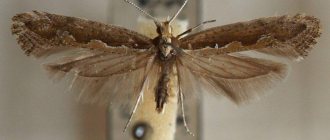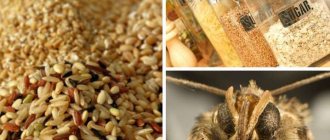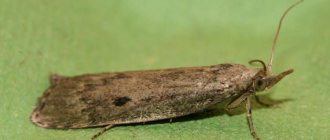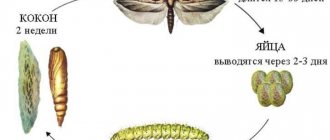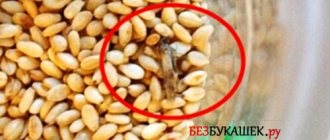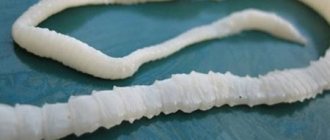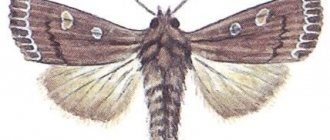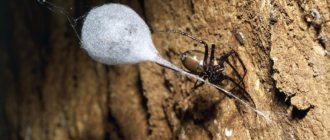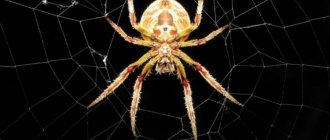Food moths are perhaps the most common food pest. What needs to be done to quickly rid kitchen cabinets and sideboards along with their contents? How to permanently protect your home from the appearance of this insect?
While the moth feels like a full-fledged mistress of the kitchen, something urgently needs to be done. Otherwise, she will soon fly off to explore the horizons of your living room, bedroom and other areas of the apartment. It is unlikely that a food moth will encroach on fur items in a closet, furniture or fabrics (for this it has distant “relatives” - fur moths, furniture moths and clothes moths), but to see it sitting on the ceiling and walls of different rooms is, at least, unpleasant . As a maximum, after an inspection of the kitchen, you will still have to frantically scour the auxiliary rooms, which are the pantry and the balcony, in search of cereals, dried fruits and dried mushrooms that were accidentally forgotten there. You probably already understand how to cultivate moths at home. It's time to get rid of her.
What does food moth look like (photo)
Food moth.
Type and lifespan
Name: Food moth Lat.:
Sitotroga cerealellaClass: Insects - Insecta Order: Lepidoptera - Lepidoptera Family: Lepidoptera - Gelechiidae
| Habitats: | kitchen cabinets |
| Dangerous for: | groceries, fruit |
| Means of destruction: | chemicals, folk remedies |
Food moth caterpillar.
Many people know what food moth looks like. Most often, so-called flour moths appear in the kitchen. It looks like a small butterfly, reaches up to 10 mm in length, its color is discreet, its wings have a silvery coating, and the caterpillar is pink or light yellow.
Ideal conditions for development are +20-25 degrees and humidity 50%. All stages of development from egg laying to the appearance of the moth take about 1.5 months.
Harm and danger
Many people believe that the insect is absolutely harmless to humans; it’s okay if it eats a couple of grains. It is strictly forbidden to think so. The main problem with grain moths is that an adult can lay about 500 eggs. Each larva changes its skin several times during its short life and contaminates food with its vital activity. Cereals and nuts contain a lot of feces and chitinous covering (insect skin).
Regular consumption of contaminated foods, sometimes even one meal, can lead to dire consequences:
- food poisoning, serious intoxication of the whole body;
- severe allergic reaction, including angioedema, which sometimes leads to death;
- malfunctions of the immune system.
All doctors and exterminators insist that after discovering insects in the kitchen, you need to get rid of them very quickly. Food moths pose a particular danger to children. A fragile body may react acutely to a meal of contaminated foods.
What does it eat and what is it afraid of?
Traces of moth activity.
The moth feeds in the kitchen on flour, cereals, bran, pasta, dried fruits, nuts, and dried mushrooms. You can notice it by the grains stuck together, somewhat similar to a cobweb.
Plastic bags are not a hindrance for moth larvae; they easily gnaw holes in them and easily migrate from one bag to another if they lack food.
Butterflies cannot tolerate specific odors, for example, fresh orange peels, garlic cloves, bay leaves, lavender, mint, tansy. But these methods are only applicable against butterflies; aromas do not affect the larvae and eggs.
To destroy food pest larvae, there are household chemicals.
How to recognize a pest?
The moth, or as it is popularly called the “food moth,” is a pest that, while in the caterpillar phase, feeds on groceries, nuts and dried fruits. In fact, there are several species of this butterfly, and each of them has its own characteristics. But in general, any food moth will be quite inconspicuous, and the faded pattern on the wings helps it in this.
But the larvae of these pests, as they say, look the same. They look like caterpillars, the body of which is painted pale yellow or pale pink. While in this phase of development, the food moth leads a hidden lifestyle; it constantly lives in a bag of food and crawls out of it only during the pupation period. It is at this stage of their existence that thick caterpillars can be detected with the naked eye - they will crawl along kitchen surfaces, most often along the walls of cabinets in which they parasitized. Adult butterflies no longer spoil food, but only mate and thereby increase the size of the colony.
On a note! It is for this reason that it is useless to fight food moths by destroying only winged individuals! After all, at the same time, somewhere in the kitchen cabinet, caterpillars are already living and parasitizing, which spoil your food supplies!
Where does the food moth live and what does it eat?
Absolutely all groceries are attractive to food moths and they can be found in such food products as:
- bread and any bakery products, including breadcrumbs and regular crackers;
- absolutely any cereals and grains;
- flour and flour products, such as pasta;
- sugar;
- cocoa;
- cookie;
- nuts and dried fruits;
- mild spices, etc.
At the first stage of infection, it is quite difficult to identify parasites, since the caterpillars will be in the products. Their presence in cereals and flour will be indicated by small dark lumps and scraps of cobwebs - this is part of the cocoon with which the larvae weave themselves during the process of parasitism. If a pest has taken a fancy to a bag of nuts, then there will be neat small holes on them, and when the shell is broken, the same caterpillar will be inside.
Lifespan
Life cycle of a moth.
After mating, kitchen moths look for a moist, warm place where they will lay eggs. She needs 5-7 hours for fertilization and laying, after which she dies.
It takes 5-7 days from the maturation of the eggs to the appearance of the larvae. At one time, the female lays 50-100 eggs; they are very small, and it is almost impossible to notice their presence on food.
After emergence, the larva begins to eat food and throw waste into it. Cocoon formation is the final stage when cobwebs or balls appear in products.
The life cycle from egg to mating adult lasts 6-8 weeks.
What harm does
Moth in the cereal.
Unlike ordinary butterflies, which breed in the summer, the food species in an apartment can breed all year round. This is one of the reasons why food moths are dangerous and why they need to be removed as quickly as possible.
It usually starts in products that have expired or when sanitary rules are violated. She wanders around the kitchen cabinet and eats everything that comes in her way. The pest especially loves cereal products, pasta, flour, nuts, dried fruits, and candies. All products that end up in cabinets contaminated with moths and their larvae will be spoiled.
You may wonder if food moths eat clothes. The answer is clear: it is not dangerous for fur and wool products.
Life cycle
Food moths have a short life cycle. If temperature conditions and humidity are optimal, the cycle lasts from 6 to 8 weeks. Favorable temperatures for insects are around 25°C and air humidity around 50%. In such conditions, the pest develops very quickly, and removing it is extremely problematic.
Separately, it should be said about what food moths eat. Only larvae feed, they are voracious, and their diet includes a variety of human foods. But adult individuals do not eat, since they have neither mouthparts nor digestive organs. The life of an adult insect is short, no more than a week, and is intended only to perform the reproductive function. Mating takes place already on the next or second day after emergence from the cocoon.
When talking about how the pest reproduces, it must be taken into account that the female prefers to mate and lay eggs in the same place where the larvae already live. In rare cases, insects mate away from human habitation, and then the female returns to the larval feeding area to lay eggs. After mating, males either continue searching for females or die.
If we talk about how long a food moth lives, taking into account the larval phase, it turns out to be about a month and a half. Of this period, the development phase in the cocoon takes almost two weeks.
Reasons for appearance
Cereals infested with moths.
At home, moths can appear in products brought from the supermarket, contaminated with eggs, but invisible to the eye. Food moth larvae appear most often Therefore, to avoid this problem, buy products from trusted stores and carefully check the tightness and appearance of the packaging.
Moths can travel from neighbors if they have such a problem. Through a window or vent, she may travel in search of food.
Ways to fight
If you do not fight the insect, it multiplies quickly and affects a large amount of food. Stopping the process will be much more difficult than at an early stage. Therefore, it is important to carry out some measures to detect and eliminate parasites. So, here's how to deal with food moths.
We are conducting an audit
Products in the kitchen cabinet need to be carefully examined; the presence of lumps or cobwebs indicates pest infestation. For reliability, it is better to process all cereals before storage: place in the freezer for 2-3 hours or in the microwave at maximum power for 30 seconds.
Proper storage of cereals is the key to their purity.
Processing and cleaning of kitchen furniture
How to get rid of food moths in the kitchen, these methods will help.
- The first step is to go through all the corners and crevices of the cabinets and throughout the kitchen with a vacuum cleaner.
- Wash everything with soapy water and wipe the shelves with vinegar.
- Wash curtains, tablecloths, towels.
- After cleaning, ventilate the room.
Pheromone traps for adults
Pheromone traps.
Mostly male moths migrate. Traps containing pheromones attract females. When they sit on the sticky parts of the traps, they die.
Velcro is also made using this principle to kill adult specimens. This kind of bait should be used with caution so as not to lure even more male moths to the scent of the female.
Household chemicals
There is no shortage of household chemicals, so you can choose a product that is ideal for your specific situation.
Aerosols and sprays must be applied carefully so that they do not come into contact with food.
Gels and pencils will help in the fight against moths. Inexpensive but effective are crayons .
Fumigators, such as raptor, act on adults and are not dangerous to the larvae.
Folk remedies
Lavender and mint repel moths.
Folk remedies will help you get rid of food moths in your closet or pantry. This is more of a preventive measure, but the smell of some plants repels moths. If, after cleaning, you lay out fresh orange peels, unpeeled garlic cloves, bay leaves, lavender, wormwood, mint, adult butterflies will leave their home.
Herbs can be replaced with cotton pads soaked in essential oils. You can use sachets with mixtures of herbs against moths, which need to be placed in the kitchen in food storage areas.
The article at the link suggests 20 effective ways to get rid of moths.
What is a moth afraid of?
Fragrant herbs: Lavender, Mint, Rosemary, Geranium and some other fragrant herbs. Place or hang a sachet with any of these herbs in each of the cabinets. A pleasant smell for humans will help get rid of adult moths, which means there will be no new clutches of eggs in new products. Garlic. Peel the garlic clove, cut into slices, place on saucers and place them in the cabinets. The pest will quickly leave its habitat, unable to tolerate the pungent odor. The advantage of garlic is that it can even be placed directly into flour and cereals. The garlic smell will not be transferred to groceries, but moths will help drive away or prevent infection. Orange peels. The sharp aroma of citrus will repel food moths from cabinets and containers with bulk products in the kitchen. The crusts need to be changed periodically, because... Over time, they cease to emit a strong aroma. Forest herbs. Collections of tansy or wormwood, dried and put in bags, will help remove not only moths, but also bedbugs and flies from the kitchen. Bouquets of herbs should be placed in cabinets. Bay leaf is a plant that also belongs to the esters and has a pungent odor. Camphor. The pungent smell of essential camphor oil or even camphor alcohol (which is sold in pharmacies) will drive food moths out of your kitchen for a long time. You can also soak cotton pads in camphor and place them in cabinets. As the aroma of the ether wears off, the cotton pads should be changed. Walnuts. Another effective remedy against food moths is fresh walnut leaves. Leaves are laid out around the kitchen and in cabinets where cereals are stored. For effective control, it is necessary to periodically replace wilted nut leaves with new, freshly picked ones.
Preventive measures
When replenishing your food supply, it is important to remember some preventive measures:
- Be careful when purchasing groceries at low prices, checking the expiration date and condition of the packaging.
- Before storing, treat with cold or high temperature.
- Store all products in airtight containers.
- Use moth repellents.
- Do not stock up on large amounts of food.
- Monitor the condition of kitchen cabinets, wash and ventilate them regularly.
- Conduct an inspection of existing inventory.
Following preventative practices will help preserve food.
Where does the parasite come from and where does it live?
These questions worry many housewives, because many believe that they themselves are to blame for the contamination of food with insects. You can’t assume that, you can only take care of your kitchen, but it’s impossible to watch other people. Often, goods purchased in a store (especially on sale) are already contaminated with moth larvae. Unscrupulous owners of wholesale warehouses neglect the rules for storing products. Insects also make their way into the home through ventilation, through windows.
How to get rid of mold that looks like cotton wool in the cellar? Check out a selection of effective methods.
Effective folk remedies for moths in the apartment are described on this page.
Favorite places for food moths:
- cereals The favorite habitat of grain moths: rice, oatmeal, rolled oats, pasta, even portioned bags of cereals are not immune to pest infestation;
- nuts. The moth lives in shelled peanuts, under the shells of walnuts;
- dried fruits. Raisins, prunes, dried apricots are often covered with some kind of mold due to moth enveloping the product;
- carton boxes. Sometimes the larvae are found in unpacked packets of tea, cornflakes, or oatmeal;
- if insects have been living in your kitchen for a long time, then perhaps they live under window sills, behind cabinets; there are rare cases of grain moths living even in household appliances that have not been used for a long time;
- There is an opinion that insects are afraid of garlic, but some claim that they have found larvae even in bags of vegetables;
- There are foods that moths do not eat, but live in them well (salt, soda). When inspecting the kitchen, pay attention to these bulk items.
Caustic (vinegar) and viscous (honey, wait, jam) are not susceptible to infection, because insects simply drown in them.
You shouldn’t panic when you discover a pest; gather yourselves and immediately begin destroying grain moths.
